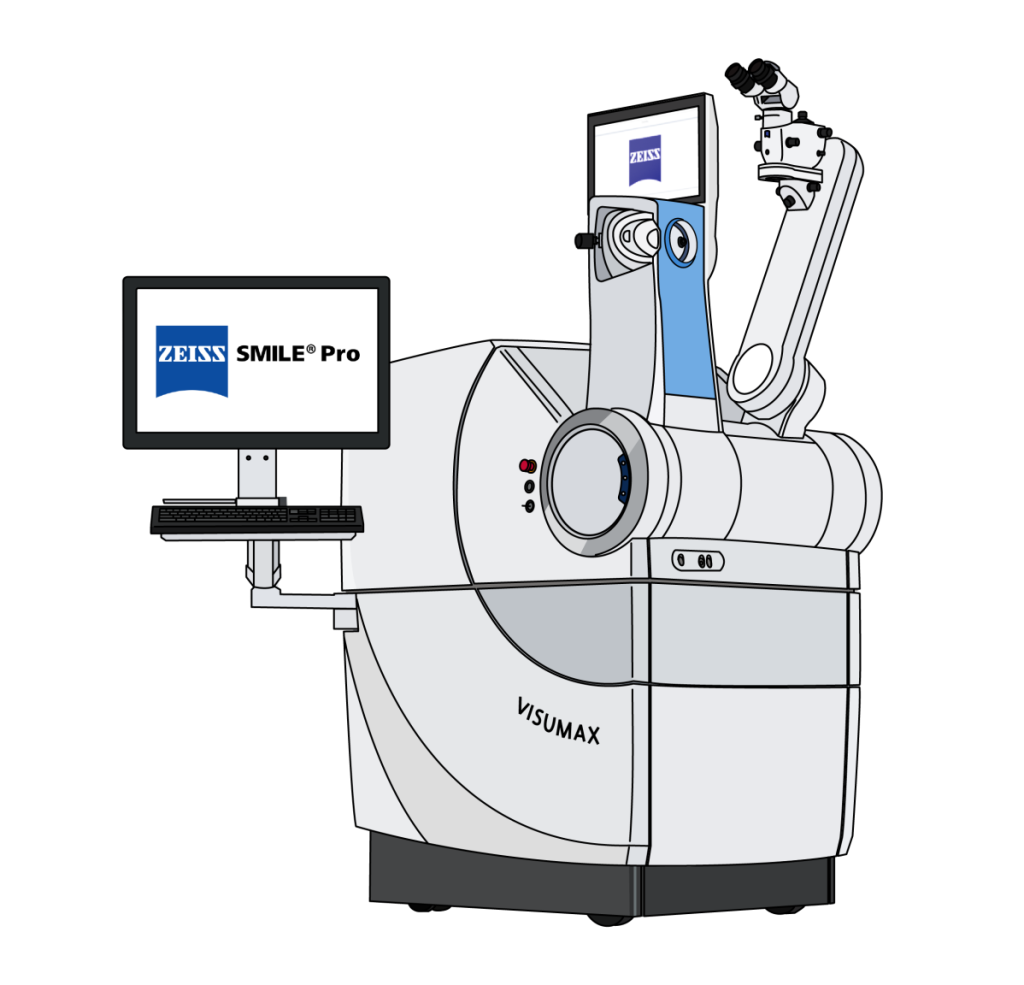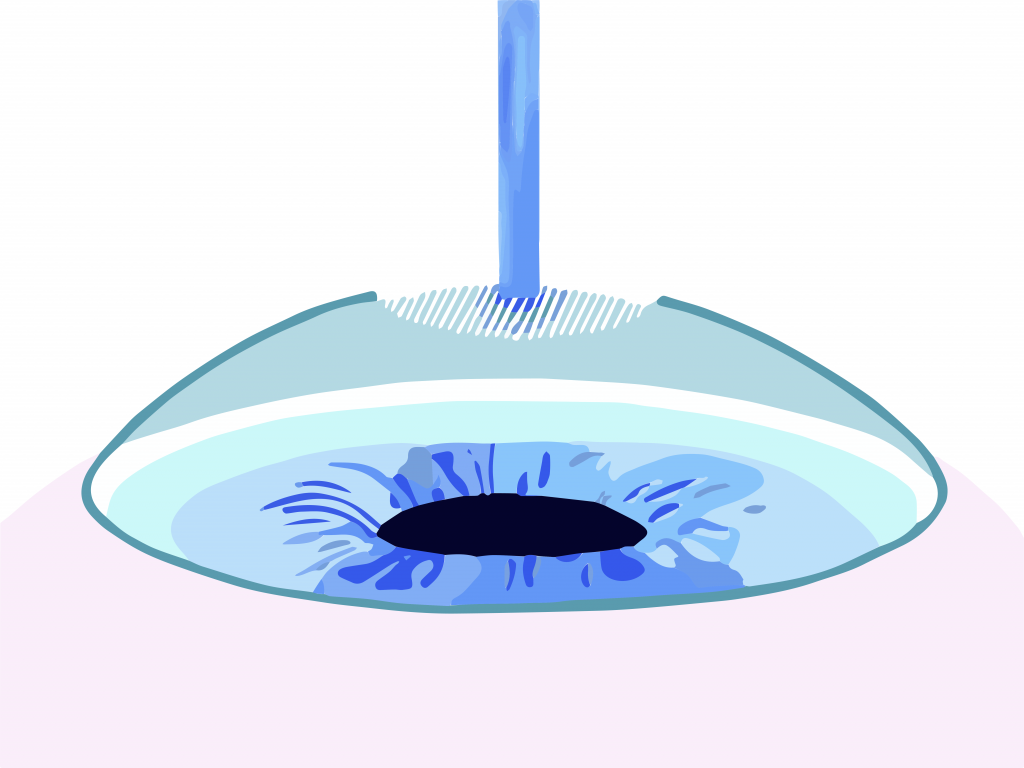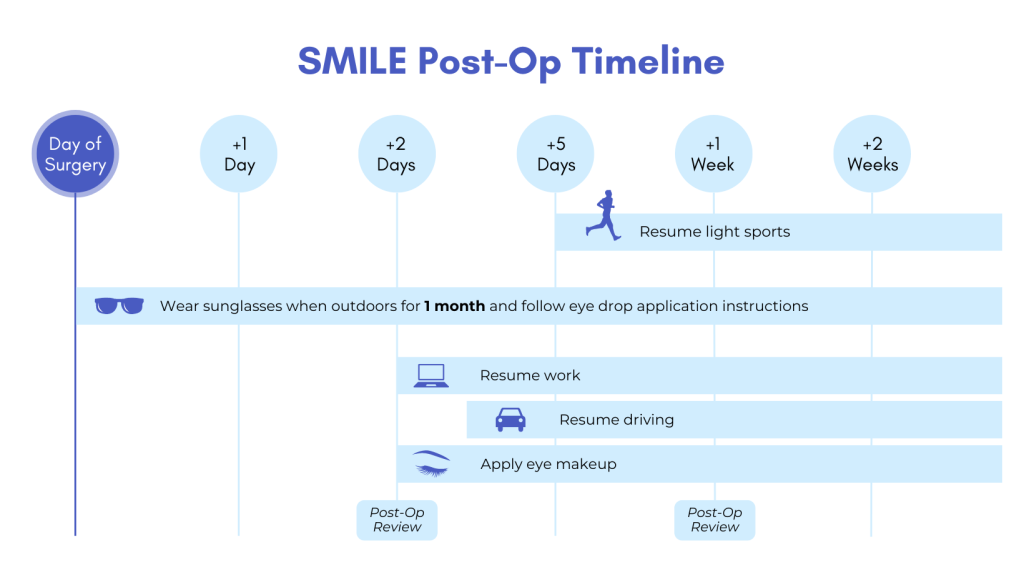If you’re reading this, you’ve most probably started to get so sick and tired having to wear glasses and contact lenses, that you’ve decided it’s time to get your vision corrected. You’ve also probably gotten equally sick and tired of trying to decide which laser vision correction method to go for.
If the above assumptions are true, congratulations! You’ve not only taken a step in the right direction for your eyes, but you’ve also found what we hope will be the article that decides it for you.
So with a life free from glasses and contact lenses awaiting, let’s get on with comparing two well-known minimally-invasive laser vision correction procedures – TransPRK and SMILE.
Intro

TransPRK (Transepithelial PhotoRefractive Keratectomy) is an Advanced Surface Ablation (ASA) procedure, meaning that there is no cutting to create a flap in order to allow the laser to access and reshape the cornea. Instead the laser simply ablates (surgically removes) the outermost layer of cells on the surface of the eye to reach the cornea.
What makes TransPRK different from other ASA procedures such as traditional PRK and Epi-LASIK, is that there is nothing actually physically touching your eye (besides an eye clamp to gently keep your eyelids open) in order to remove the surface cells.
This results in a quick surgery for the patient (5 mins per eye), and more importantly a fast and comfortable healing process as compared to other forms of ASA.

SMILE (Refractive Lenticule Extraction, Small Incision Lenticule Extraction) was created with the aim of bringing over the benefits of LASIK – a quick recovery with little to no discomfort – while being minimally invasive. It makes use of the removal of a tiny lens-shaped piece of corneal tissue within the eye, to reshape the cornea.
This tiny lens is referred to as the lenticule, and the minimally invasive 2 mm micro-incision (as compared to LASIK’s 22 mm flap cut) through which it is extracted from, contributes to SMILE’s fast and comfortable healing process – patients are able to go back to work in around 2 – 3 days.
Unlike LASIK, no corneal flap is created which means that you do not get the risk of flap complications (dislodgement, wrinkles, inflammations) or dry eyes.
History
TransPRK
TransPRK was made possible with the introduction of the Schwind Amaris 1050RS excimer (gas) laser in 2013, and is the much improved version of traditional PRK, which was the very first laser vision correction method introduced into the world. PRK has been around since the early 1990s, and through the decades we have seen multiple iterations of ASA procedures, leading up to what we have today with TransPRK.
SMILE
SMILE was introduced in 2011 by ZEISS, as ReLEx SMILE. It is performed using the ZEISS VisuMax femtosecond (ultrashort pulse) laser. Because of its safe treatment and quick recovery, SMILE was brought into Singapore in 2014. And in 2016, it was introduced into the US after passing the US Food and Drug Administration’s (FDA) notoriously strict regulations and safety standards.
Treatable Conditions
TransPRK
- Hyperopia (longsightedness – difficulty seeing objects up close)
- Myopia (shortsightedness – difficulty seeing objects at long distances)
- Presbyopia (difficulty focusing on objects up close, in older age a.k.a. lao hua yan)
- Astigmatism (distorted, blurry vision at any distance)
SMILE
- Myopia (shortsightedness – difficulty seeing objects at long distances)
- Astigmatism (distorted, blurry vision at any distance)
Suitability
TransPRK
Ideally, corneal thickness should be at least 485 microns thick.
Corneal cross-linking (CXL) is advisable as an adjunct treatment if your cornea is thin, or you have high astigmatism and/or high myopia (more than -8 diopters [800 degrees]). This procedure strengthens the cornea to prevent it from changing its shape in the future.
If you have myopia, your prescription must not be more than -10 diopters (1,000 degrees).
For hyperopia, not more than -4 diopters (400 degrees).
For astigmatism, not more than -5 diopters (500 degrees).
SMILE
Ideally, corneal thickness should be at least 550 microns thick, meaning that thinner corneas might not be eligible.
Corneal cross-linking (CXL) is not advisable as an adjunct treatment if your cornea is less than 550 microns thick. We typically recommend going for TransPRK if your cornea is too thin.
If you have myopia, your prescription should be between -2.5 to -8 diopters (250 – 800 degrees).
Hyperopia is not treatable by SMILE.
For astigmatism, not more than -2.5 diopters (250 degrees).
Please note, you will not be suitable for TransPRK or SMILE if you:
- Are pregnant or breastfeeding
- Are under the age of 18 (parental consent is required if you are under the age of 21)
- Have severe dry eye syndrome
Technology
TransPRK

For our Safe Sight TransPRK procedures at Clearvision, we use the Schwind Amaris® 1050RS, which is able to treat 100 degrees of myopia in only 1.3 seconds. It is also equipped with features such as 7-dimensional eye tracking and zero latency tracking technology, which allows accurate treatment as it takes into consideration the tilt and roll of the eyeball. This translates into a short surgery, as well as high accuracy, consistency and comfort for our patients.
Schwind Amaris® 1050RS
- 1050 Hz pulse rate enables a fast and comfortable procedure
- 7D eye tracking provides precision and accuracy
- SmartSurfACE provides safe, gentle, and touch-free treatment
SMILE

For our SMILE procedures at Clearvision, we use the ZEISS VisuMax 800 femtosecond laser, which implements femtosecond laser technology known for its precision, speed and gentle treatment technique. Its minimally invasive approach does not require the creation of a corneal flap – instead it creates a lenticule inside the cornea and a small incision, in just one single step. With a pulse frequency of 2000 kHz, the ZEISS VisuMax® enables short treatment times, making procedures easy and comfortable for our patients.
ZEISS VisuMax 800
- Lenticule creation and incision are performed in just one step
- Minimally invasive flapless procedure allows for quick, comfortable healing
- Femtosecond laser provides precision, speed and stability
Procedure Steps
TransPRK
Length of surgery: about 5 minutes per eye
- Put on your surgical gown and other protective equipment
- Lie flat and get comfortable on the operating bed.
- A clamp is then used to gently keep your eyelids open
- Numbing eye drops are added so that your eye does not feel anything
- Your eye is lined up in the optimal position for the laser
- You stare straight at the dim green guiding light
- The laser starts to ablate the surface cells (you might smell a slight burning smell)
- The laser then starts to reshape the cornea
- Your vision has been corrected!
- A bandage contact lens is placed over the eye to allow the surface cells to safely heal (to be removed after 1 week by the doctor)
You will be able to see immediately after the surgery. But as the surface cells heal in the next few days, your vision will get more blurry.
It should take up to 1 week for the cells to fully heal and for the blur to go away, after which you can resume your day to day activities and go back to work.
You will be given 1 week of medical leave.

SMILE
Length of surgery: about 10 minutes per eye
- Put on your surgical gown and other protective equipment
- Lie flat and get comfortable on the operating bed.
- A clamp is then used to gently keep your eyelids open
- Numbing eye drops are added so that your eye does not feel anything
- Your eye is lined up with the contact glass, which uses low suction pressure keep your eye in position
- You stare straight at the dim green guiding light
- The laser creates a lenticule (small lens shaped piece of corneal tissue)
- The laser then seamlessly makes a small micro-incision of 2 mm
- The lenticule is removed through this small incision, changing the shape of the cornea
- Your vision has been corrected!

Your vision will be blurry immediately after the surgery. But your vision will clear up the next day, and continue to get less blurry in the next few days.
It will take around 2 days for your eye to heal and for the blur to go away, after which you can resume your day to day activities and go back to work.
You will be given 3 days of medical leave.
Recovery Process
TransPRK
Full visual recovery, where your vision has totally stabilised and your eyes are consistently seeing very clearly, takes up to 3 months (patients with high myopia may take even longer).
Patients are required to follow a strict routine of eye drops application. TransPRK requires 4 types of eye drops to be applied multiple times a day for at least the first week, after which number and frequency of eye drops will decrease (eye drops application can continue for up to 3 months or longer), depending on how the patient’s eyes heal.
Protective sunglasses must be worn whenever outdoors for 1 month, to prevent UV exposure which can be harmful to the healing process. (UV blocking sunglasses are provided to Clearvision patients).

SMILE
Full visual recovery, where your vision has totally stabilised and your eyes are consistently seeing very clearly, takes 1 – 2 months (patients with high myopia may take up to 3 months)
Patients are required to follow a strict routine of eye drops application. SMILE requires 2 types of eye drops to be applied multiple times a day for at least the first week, after which number and frequency of eye drops will decrease (eye drops application can continue for up to 1 month or longer), depending on how the patient’s eyes heal.
Protective sunglasses must be worn whenever outdoors for 1 month, to prevent UV exposure which can be harmful to the healing process. (UV blocking sunglasses are provided to Clearvision patients).

Post-Operative Follow Up Reviews
TransPRK
After surgery, you can expect to return to the clinic for follow-up reviews at these points during your recovery:
- 1 day / 2 days post-surgery (depending on what day of the week you had your surgery)
- 1 week post-surgery
- 2 weeks post-surgery
- 1 month post-surgery
- 2 months post-surgery
- At some point(s) between 3 – 6 months post-surgery (especially if you had high myopia)
More follow-ups may be required, subject to the individual’s healing progress.
SMILE
After surgery, you can expect to return to the clinic for follow-up reviews at these points during your recovery:
- 1 day / 2 days post-surgery (depending on what day of the week you had your surgery)
- 1 week post-surgery
- 1 month post-surgery
- 2 months post-surgery
More follow-ups may be required, subject to the individual’s healing progress.
Resuming Regular Activities
TransPRK
Post-TransPRK, you will be allowed to resume these activities after a specific period of time:
- Light sports: 5 days
- Longer sessions of reading, computer work: 1 week
- Driving: 1 week
- Applying eye makeup: 1 week
- Showering without having to make sure that no water enters the eyes: 1 week
- Swimming, other water related activities : 2 weeks
- Contact sports: 2 weeks

SMILE
Post-SMILE, you will be allowed to resume these activities after a specific period of time:
- Longer sessions of reading, computer work: 2 days
- Applying eye makeup: 2 days
- Showering without having to make sure that no water enters the eyes: 2 days
- Driving: 3 days
- Light sports: 5 days
- Swimming, other water related activities : 2 weeks
- Contact sports: 6 weeks

Pros
TransPRK
- No flap-related complications
- Low risk of dry eyes
- Ability to participate in contact sports
- No surgical instruments touching the cornea
- Wide range of suitability criteria (high myopia, thin corneas etc.)
- Length of surgery is short (5 mins per eye)
SMILE
- No flap-related complications
- Low risk of dry eyes
- Ability to participate in contact sports
- Little to no discomfort during recovery
- Quick initial recovery, with just 2 days of downtime. Quick full visual recovery, with most patients expected to achieve a stabilised visual clarity after 1 month (patients with higher myopia may take longer, up to 3 months)
- Less follow up reviews and medications required
Cons
TransPRK
- Some discomfort early on during the healing process (mild itchiness or soreness on the surface of the eye)
- Slower initial recovery of surface cells, resulting in 1 week of downtime. Slower full visual recovery, with patients expected to achieve a stabilised visual clarity in 2 – 3 months (patients with higher myopia may take longer)
- More follow up reviews and medications required
SMILE
- Narrower range of suitability criteria (hyperopia, high myopia or thin corneas not eligible)
- SMILE can only be performed once, meaning that any future enhancements or corrections will have to be done using TransPRK
Price at Clearvision Singapore
TransPRK
S$4,388 for both eyes, inclusive of GST
SMILE
S$5,388 for both eyes, inclusive of GST
Prices comprise of:
- Surgery for both eyes
- First set of medications
- First week of post-op reviews
- One pair of UV-protected sunglasses
Important Notes –
- A suitability evaluation is first required and will cost S$55 (inclusive of GST).
- The amount of medications and post-op reviews required depends on the patient’s healing
- Consultations after the first week will be chargeable
- Subsequent medications will be chargeable
Conclusion
We hope that this comparison between our most popular laser vision correction methods will help you decide which one is best for yourself. Whichever procedure you choose, we can’t tell you enough how excited we are for you to live life with clear vision, where you will finally be able to see well while:
- Swimming or doing any water-related activities
- Taking a shower
- Relaxing in a spa / sauna
- Getting a haircut (no more surprises after you put your glasses back on)
- Getting trapped in the rain
- Trying to look at the clock on your bedroom wall in the morning
- Rushing to the restroom in the middle of the night
- Riding a high-speed roller coaster
- Exiting an air conditioned area (goodbye foggy glasses)
- Wearing a mask (goodbye again foggy glasses)
- In between naps on a long-haul flight (no more fumbling for your glasses)
And for contact lens wearers, not having to deal with all the expenses, inconveniences, infections, and dry eyes that come with it!
Book Your Eye Evaluation
If you would like to book a suitability evaluation with us to determine if you are eligible for TransPRK and/or SMILE surgery,
📞 Call us at 6733 3316
📱 WhatsApp us at 8383 7989
✉️ Email us at doctor@clearvision.com.sg
🤳 Message us on Facebook
🤳 Message us on Instagram
The evaluation costs $55 and will take around 1 – 2 hours.
It will include a series of eye tests as well as a personal consultation with your lasik surgeon.
Suitability Evaluation Guide
Our suitability evaluations typically take place during these times, subject to availability –
| Mondays | 2:30 PM – 3:30 PM |
| Tuesdays | 9:00 AM 2:30 PM – 5:15 PM |
| Wednesdays | 9:00 AM |
| Thursdays | 2:30 PM – 3:30 PM |
| Fridays | 9:00 AM – 11:00 AM 2:30 PM – 5:15 PM |
Just let us know which days and times work for you and we’ll do our best to accommodate.








